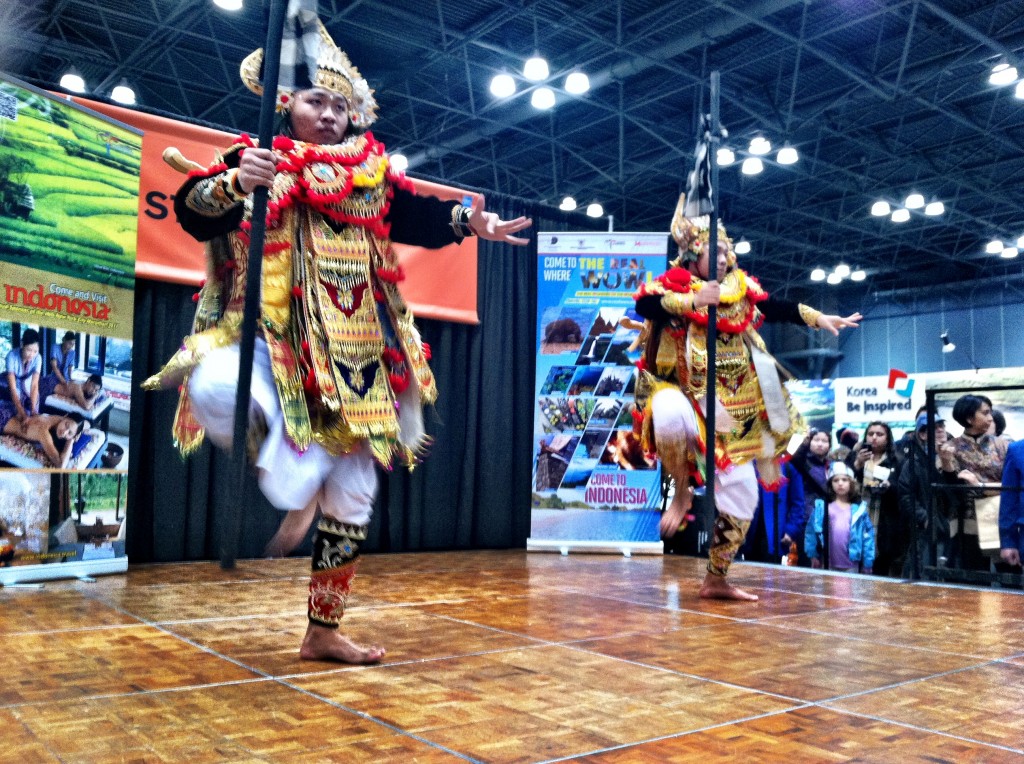At the New York Times Travel Show, I managed to get to 95% of the booths on the show floor and while I received a warm and inviting response from everyone, there were a few stand-outs from a cultural perspective…in other words, exotic colors, costumes, food and music flew from their booths. Indonesia performed some colorful dances, gave me meatballs and bananas and consistent smiles every time I breezed past.
On Saturday, they performed the Nandak Ganjen Dance, a dance from Jakarta, strongly influenced by Chinese culture, a new creation originating from Gambang Kromong folk art. The dance depicts lively young girls celebrating their journey to adulthood, expressing happiness and freedom of a woman in the making. The Merak Dance is a female dance as well, and inspired by the beautiful movements of a peacock.
The Baris Mapatra Yudha Dance is one of the most important ritual dances in Bali (above) and it derives its name from the word “bebarisan” which literally means a line or file of formation. It refers to the ancient Balinese soldiers who were used by rajaraja, the Balinese kings to protect their kingdom in times of disturbance. Aside from its ritualistic function, the baris is also known as the warrior drill dance.
The ritualistic function of this dance is to show physical maturity and it is performed by two to sixty dancers. This dance was re-choreographed by Prof. DR. I Made Bandem.
For more on our events, check out our Events and Festivals section.

Renee Blodgett is the founder of We Blog the World. The site combines the magic of an online culture and travel magazine with a global blog network and has contributors from every continent in the world. Having lived in 10 countries and explored over 90, she is an avid traveler, and a lover, observer and participant in cultural diversity. She is also the founder of the Magdalene Collection, a jewelry line dedicated to women’s unsung voices and stories, and the award-winning author of the bestselling book Magdalene’s Journey
She is founder of Blue Soul Media and co-founder of Blue Soul Earth as well as the producer and host of the award-winning Blue Soul CHATS podcast, that bridges science, technology and spirituality. Renee also founded Magic Sauce Media, a new media services consultancy focused on viral marketing, social media, branding, events and PR. For over 20 years, she has helped companies from 12 countries get traction in the market. Known for her global and organic approach to product and corporate launches, Renee practices what she pitches and as an active user of social media, she helps clients navigate digital waters from around the world. Renee has been blogging for over 16 years and regularly writes on her personal blog Down the Avenue, Huffington Post, BlogHer, We Blog the World and other sites. She was ranked #12 Social Media Influencer by Forbes Magazine and is listed as a new media influencer and game changer on various sites and books on the new media revolution. In 2013, she was listed as the 6th most influential woman in social media by Forbes Magazine on a Top 20 List.
Her passion for art, storytelling and photography led to the launch of Magic Sauce Photography, which is a visual extension of her writing, the result of which has led to producing six photo books: Galapagos Islands, London, South Africa, Rome, Urbanization and Ecuador.
Renee is also the co-founder of Traveling Geeks, an initiative that brings entrepreneurs, thought leaders, bloggers, creators, curators and influencers to other countries to share and learn from peers, governments, corporations, and the general public in order to educate, share, evaluate, and promote innovative technologies.









